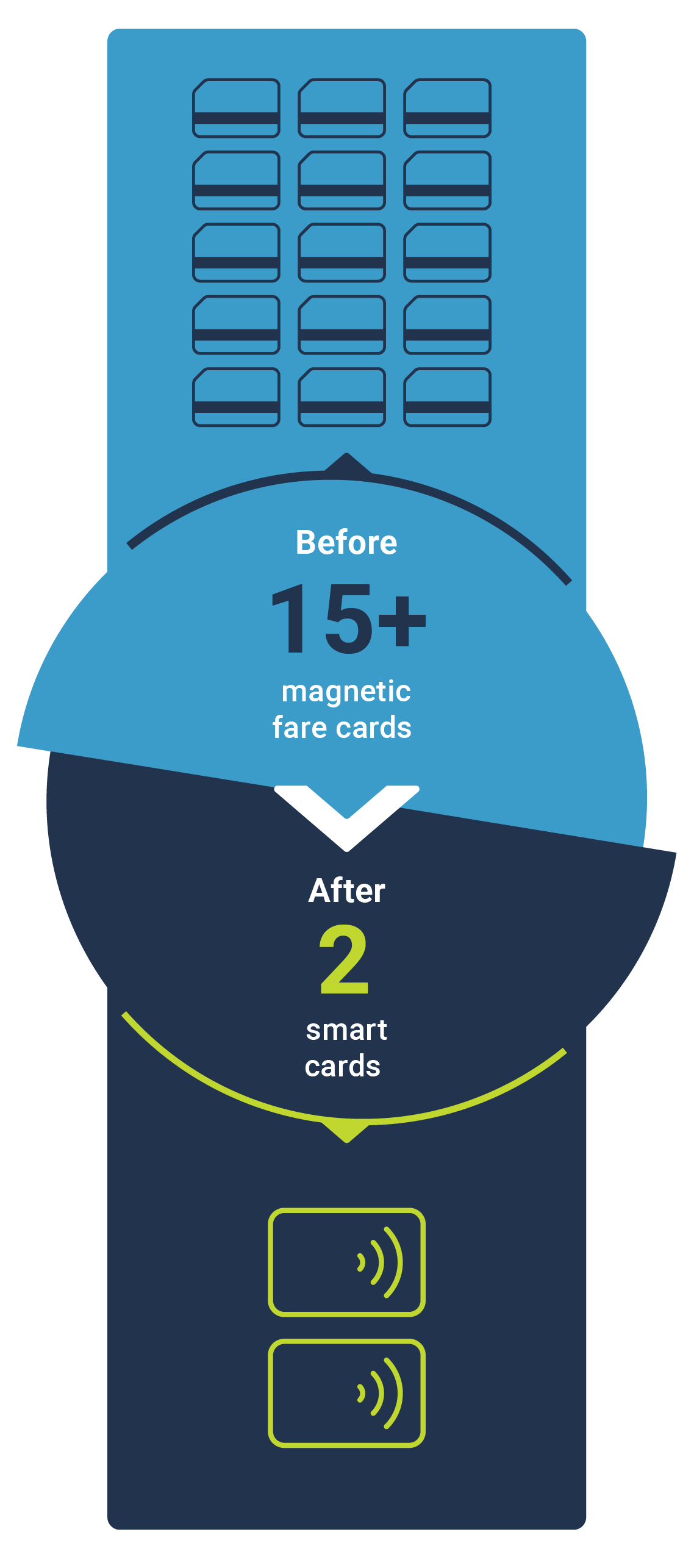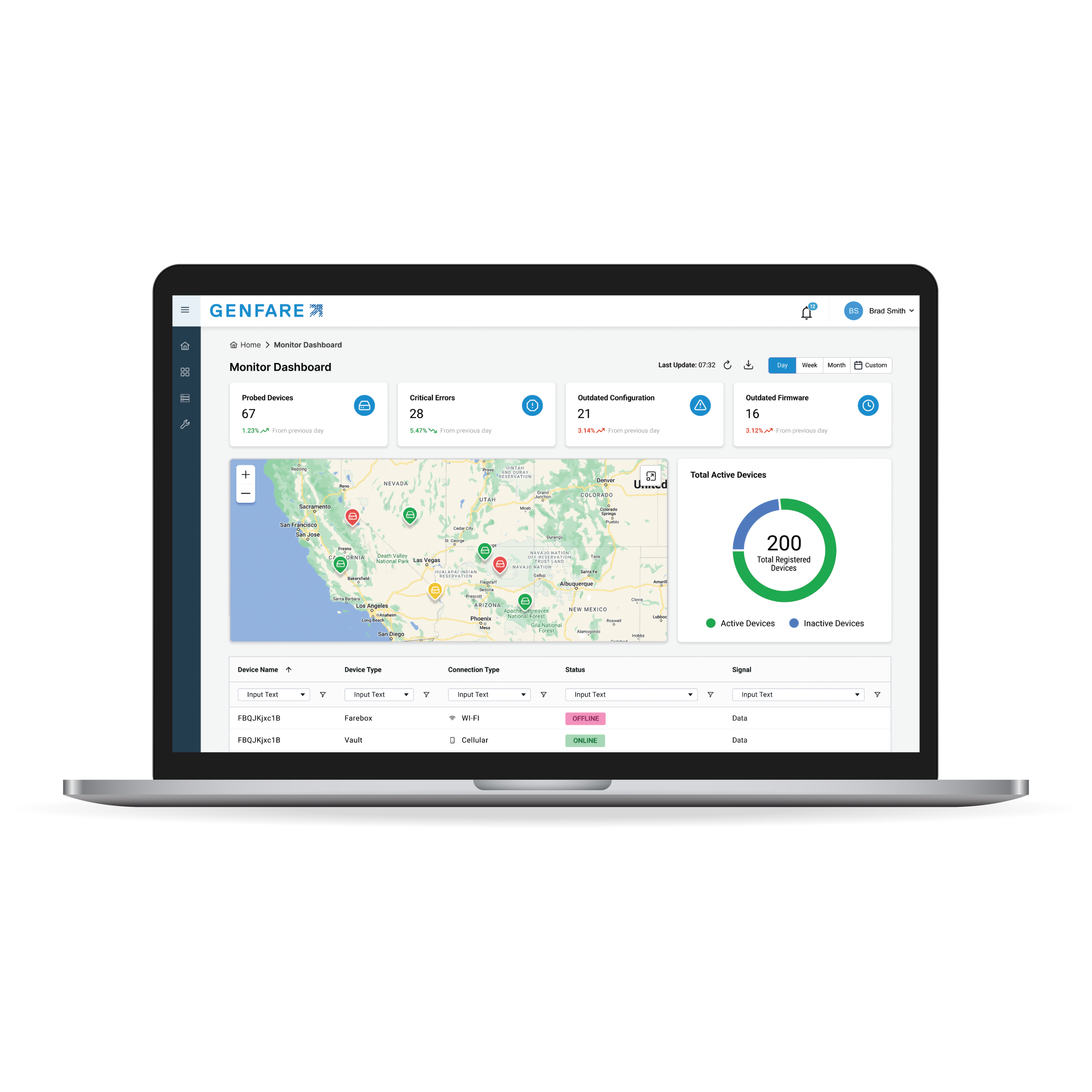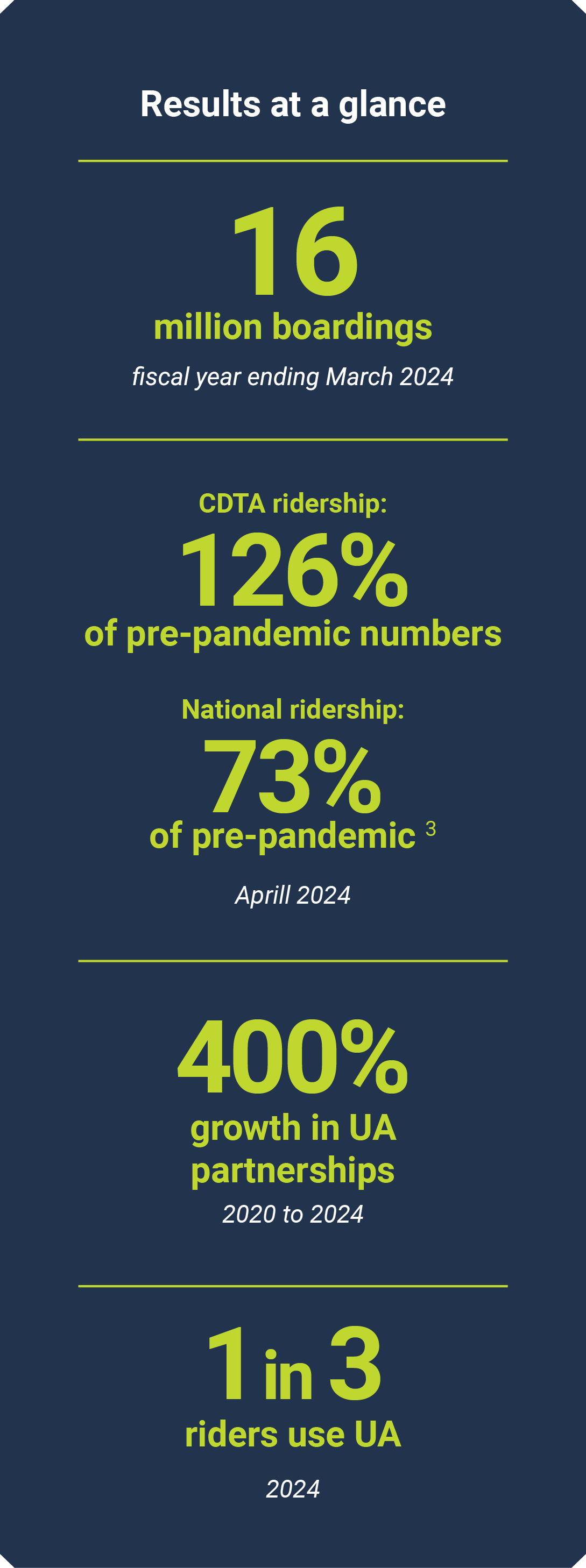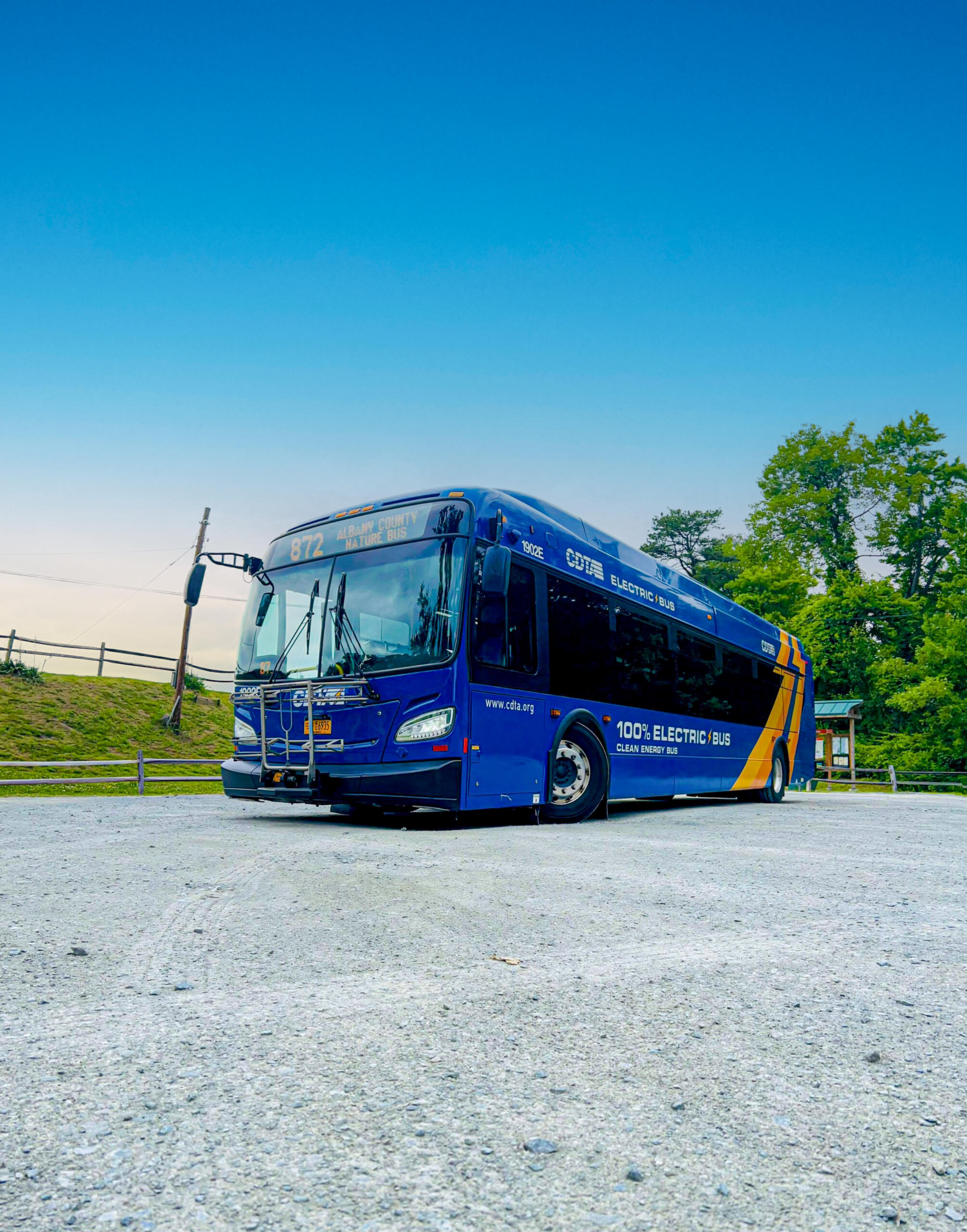
Overview
For 50 years, Capital District Transportation Authority (CDTA) has transported millions of college students and 9-to-5-ers to and from classes and work in the greater Albany, New York, area. The service region spans six counties and 2,300 square miles, transporting over 55,000 riders working in government, healthcare, industrial, and higher education each weekday. Albany’s proximity to the Finger Lakes, Catskills, and Adirondacks also makes CDTA a popular transit option for tourists. This combination of workers, students, residents, and visitors brings its total customer base to 800,000 people.
Like the rest of the country, the region’s vibrancy waned when COVID-19 stay-at-home orders impacted the community’s ability to get around. With no place to go, ridership began to decline in March 2020 from a peak of nearly 400,000 riders just two months earlier in January. By April, CDTA was at only 20% of its pre-pandemic ridership.
Once pandemic restrictions eased and people started adjusting to the “new normal,” ridership slowly began to rebound. But getting ridership and revenue back up to pre-pandemic numbers required CDTA to digitally transform its fare collection system to one that could adapt to current and future challenges—a feat that called for the agency to lean on its core values more than ever.

Solution
Achieving full pandemic recovery meant CDTA needed to take measured risks, even as the world grappled with how to weigh Covid-19 risk factors against financial and educational opportunity costs. With government guidelines changing week to week, CDTA had to create its own recovery playbook; it was committed to connecting Albany’s communities despite being faced with unprecedented circumstances.
Bring back full service
Many people in the community didn’t have the option to continue staying at home. Risk tolerance and travel needs varied from one person to the next as well. That’s why CDTA decided to be fully operational when other transit systems across the country were cutting service.
“A lot of agencies never brought their systems back to full service,” said Jaime Kazlo, CDTA’s director of communications. “So during the pandemic…we went back to what we were before the pandemic.”¹
This strategic move challenged CDTA to find operational efficiencies along bus routes in ways that maximized safety and ridership.
Invest in community relationships to stimulate economic vibrancy
To fill seats, CDTA doubled down on its Universal Access (UA) program, which provided program partners with free, unlimited bus service. Although UA was established well before the pandemic, CDTA’s accelerated partner growth was only made possible through its upgrade to Genfare Link in 2017.
Adopting Genfare Link enabled CDTA to shift administration of program partnerships onto the organizations serving the riders who benefitted from UA, expanding access without adding to CDTA’s administrative load. For example, partner organizations now have the complete access they need to fulfill customer smart card, mobile, or other point-of-sale requests without CDTA intervention.
The centralized, cloud-based platform gave the agency the boost it needed to aid pandemic recovery and become more cost-efficient. With a modernized, more flexible system in place, CDTA could finally scale UA growth to rebound ridership.
Genfare Link’s open architecture connected all available transit modalities so customers could take advantage of CDTA’s bike-sharing, FLEX On Demand Transit, group Van Pools, and electric car-sharing programs. This IT infrastructure also empowers partner organizations to add other third-party vendors, expanding the options for convenient and affordable mobility options that help to alleviate traffic congestion.
Choice riders were incentivized to opt out of driving to reduce their gas and parking expenses and some riders were able to give up owning a car entirely, saving thousands of dollars a year while alleviating traffic and environmental concerns.
The UA program gave riders more options and fewer barriers to overcome, making riding with CDTA the obvious choice. The program positioned partners as stewards of community revitalization and infused a sense of support that its members urgently needed during this time.
Simplify the customer experience
A major contributor to CDTA’s pandemic recovery success was the agency’s decision to transition to Genfare Link before the pandemic. In 2013, CDTA wanted to remove barriers to ridership, which meant relieving the fear and confusion over fare payment.

Project implementation and process
CDTA’s push to modernize its fare collection system stemmed from its desire to move away from magnetic stripe, disposable media and supporting hardware. The high cost of stocking, maintaining, and servicing magnetics “was the number one break point,” said Anya Rozanova, CDTA’s Advanced Traveler Information Systems Administrator.
The agency’s solution was to replace all magnetic media and hardware with Genfare Link-enabled smart cards. The upgrade to Genfare Link’s cloud-based technology allowed CDTA to inventory, sell, and encode smart cards in its system remotely. This transition to smart cards not only reduced operational costs for CDTA, but also cut down dwell time for riders.
After gathering input and requirements from stakeholders, CDTA submitted a proposal to build a more future-proof and scalable enterprise management system from the ground up. That request kicked off Genfare Link’s origin story with CDTA as its pioneer.
Aggressive piloting ensured customers and internal teams would be confident with navigating the new system. But given the volume and variety of magnetic stripe cards still in circulation, the agency opted for a months-long transition to give its riders time to use their change card credits. To further ensure a smooth switch, CDTA kept the smart card pricing plans and fare discount structure the same as when riders were using magnetic media.
Onboarding new UA partners became more efficient when CDTA fully transitioned to Genfare Link. Some partners needed as little as one week to be set up and trained on Genfare Link’s Organizations feature. The new system allowed partners to add or remove riders and order replacement smart cards as needed, shoring up reporting accuracy and optimizing processes.
CDTA’s new Genfare fare collection solution was “so easy to use, our passengers would not even have to think about it when they board our vehicles,” said Guggisberg. Thanks to the incremental victory approach to customer education and rollout, CDTA riders embraced the new changes.
Challenges
The world was changing and so were CDTA’s customers. The agency needed to address the challenges of its outdated system, so it reimagined a solution that would re-engage its community and keep up with their faster-paced, smarter, and convenience-driven lives. That answer evolved into Genfare Link, which enabled CDTA to recoup the financial and opportunity costs from using a fare collection system that no longer made sense for its customers and employees.
Fare validation integrity and faster boarding
Discounted fare options for riders who need financial assistance are a way to “walk the walk” of equitable mobility. But to keep this benefit secure, CDTA had to revamp its fare validation process.
Before implementing Genfare Link-enabled smart cards, discounted fare riders were issued basic, plastic ID cards or used their government-issued insurance cards or IDs for visual inspection by the operator upon boarding.
“That was a big deal because we knew we had people that were getting over on us with half-fare in terms of fraud,” said Guggisberg. So, when CDTA switched to Genfare Link, it gave the agency the opportunity to standardize security surrounding fare validation.
The new policy required every discounted fare customer to verify their identity in person and receive a smart card. With just one tap of the smart card, all fare types were automatically calculated, secured, and validated on the back end without the need for operator intervention.
These new features supported payment integrity, kept schedules on track, and promoted fewer cash transactions over time.
“From the operator dispute and customer efficiency standpoints, this made boarding and paying on the vehicle much easier. And of course, offering a simpler fare and easier options to conduct your transaction definitely made a difference [on dwell time],” said Guggisberg.
New partner opportunities and shared data
When the UA program was created 15 years ago, CDTA could only accommodate a maximum of 12 partners that its staff could create and manage in its system. For years, this limitation stunted the program’s growth and UA’s impact on Albany’s economic vibrancy.
In the beginning, UA’s founding partners primarily used student IDs to pay for bus fares, which made data integration challenging for partners and CDTA. But since implementing Genfare Link seven years ago, its open architecture has made it easier to integrate with any hardware or third-party software and improved the integration process.
Providing riders with smart cards or mobile ticketing has created partner opportunities for CDTA, such that it now has “roughly 40 to 45% of our ridership wrapped up in those kinds of arrangements. That did not exist at those numbers before [Genfare Link] went in,” Guggisberg notes.
Genfare Link’s advanced, centralized reporting offers “so much more possibility for how we can make and set up new arrangements with organizations that we contract with separately,” he adds, while giving its partners the ability to manage and share their reporting with CDTA in real-time. “That was not something we could have done before.”

Results
Pioneering Genfare Link with CDTA was an intelligent risk that showcased the technology’s ability to grow with CDTA and future-proof against unforeseen circumstances. Genfare and CDTA’s years-long partnership helped fine-tune the solution, reinforcing how essential it is for all transit agencies to have a single source of truth–an enterprise management system that can boost service quality, revenue, and employee satisfaction.
CDTA knew what it needed to transform its bus operations into a digital-first customer experience, and its tenacious innovation had an outsized impact on the business.
Increased ridership and revenue
CDTA took advantage of Genfare Link’s capabilities to actualize the UA program’s potential. The data aggregation and customer insights, for example, helped CDTA make strategic decisions that culminated in the highest annual ridership counts the CDTA has seen in the last 20 years. The agency reported 16 million boardings at the close of its fiscal year in March 2024, which was proportionally higher than all the major transit systems in the country.² By April, ridership was up to 126% of pre-pandemic numbers while national ridership was at 73%.³
CDTA’s recovery can be attributed to several factors, but “the UA program [has been] a strategic business pillar that drives our success,” said Chairman of the Board Jayme Lahut.⁴
Year-over-year, CDTA continues to surpass revenue expectations. UA currently accounts for roughly one-third of total ridership and 25 to 30% of total revenue, impacting the bottom line and strengthening economic growth in the community. CDTA credits UA for helping it outperform 2023’s 30% increase in revenue projection, leading the agency to propose another 6.3% raise for the 2024 fiscal year.⁵
Strong partner acquisition and retention
Developing and nurturing organizational partnerships built on integrity and responsiveness are core to CDTA’s growth strategy. Between 2010 and 2024, CDTA grew its UA partnerships by 400%. Now one-third of its partners also use its bike share option and several others have taken advantage of an electric car share benefit.
In the 20 years of running UA, CDTA has created an indispensable benefit for businesses on and off its bus routes. “Nobody cancels,” said Jonathan Scherzer, director of business development for CDTA. “I think the proof is in the pudding in that regard; if people weren’t happy, they’d drop it.”
It’s hard to imagine a bustling city without seeing and hearing buses whirring through the streets. It’s an essential service that supports equitable mobility and economic opportunity. That’s why CDTA and Genfare work together to respond to partner requests within 24 to 48 hours.
“Customer service is a big part of this,” Scherzer said. Regardless of the size of the business, “We try very hard to answer every one of our clients the same day or the next morning to get passes delivered to them.”
Over time, CDTA’s ubiquity has attracted larger employers that require bespoke solutions. When Amazon opened a distribution facility a mile off route, CDTA customized a route that brought 800 employees to its facility without sacrificing operational efficiency. They also did the same for Hannaford Supermarket, which requested drop-off at its front door instead of at a nearby, existing stop.
Unique partnerships like these speak to the flexibility that has been the hallmark of UA’s success, whereby CDTA leverages successful custom solutions to scale expansion.
Improved data integrity
As an early adopter of Genfare Link, CDTA was one of the first transit agencies to use its digital transformation to inform its ridership recovery strategy. The technology allowed CDTA to draw meaningful insights from annual ridership data.
“It may not seem like a big deal,” said Guggisberg, but “the actual beauty of [Genfare Link] is we can distinguish individuals riding our service versus everything just getting grouped [into one, big ridership number]. And there’s no other means for us to do that.”
Genfare Link securely gathers and validates unique customer data from multiple sources when riders use their smart cards to pay. Having this data integrity boosts CDTA’s ability to market to existing and new riders and launch more targeted and effective campaigns across the business.
Guggisberg adds, “Universal Access gets us the closest to knowing exactly who our customer is, and that is priceless. That will only continue to grow as we go forward, and thankfully the [Genfare Link] technology allows for that.”

Takeaways
Cities that adapt to their changing environments are the ones most likely to thrive, particularly when faced with extraordinary circumstances. For CDTA, its early adoption of Genfare Link gave it a head start in keeping up with digital trends and customer needs.
Embrace technological adaptability to future-proof your business
The move from magnetic media to smart card technology jumpstarted CDTA’s digital transformation. CDTA’s focus on a long-term strategy for modernizing its mobility solutions meant the agency could tolerate short-term challenges.
CDTA now leverages the cost efficiency and automated insights from Genfare Link to surpass revenue projections, increase ridership, and create economic opportunity.
Don’t wait for a solution; create the one you need today
UA’s pandemic recovery success highlights the importance of innovation. When CDTA was ready to modernize its fare collection system, it proactively worked to create one that would address its specific challenges. By the time the pandemic hit, CDTA was prepared to leverage Genfare Link to boost UA growth, ultimately restoring ridership and driving revenue at a faster rate than its peers.
The agency’s bold approach to pioneering a new fare collection system reflects the can-do attitude that helped CDTA develop key partnerships with Fortune 500 companies, small businesses, schools, and other institutions in the region.

Let values lead strategy
Digital transformation can be a bumpy ride, but it’s the critical path to meeting your customers where they are and anticipating their needs. When faced with the challenges of Covid-19, CDTA’s unwavering commitment to providing solutions-oriented transit options helped the Albany, NY, agency achieve what’s priceless: an intimate understanding of and compassion for the very people they serve.
Contact your Business Development Director to learn more about how Genfare Link can support your community’s ridership needs.

 Looking for more details?
Looking for more details?